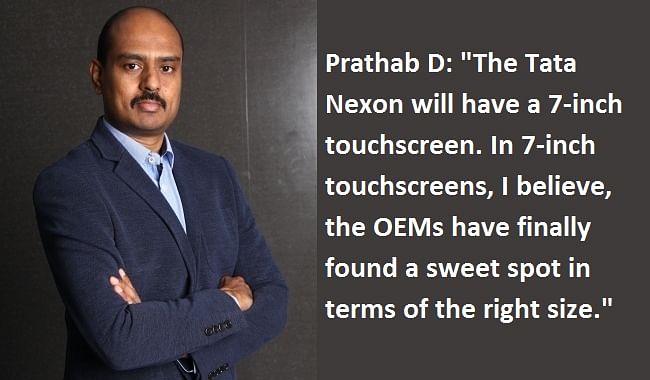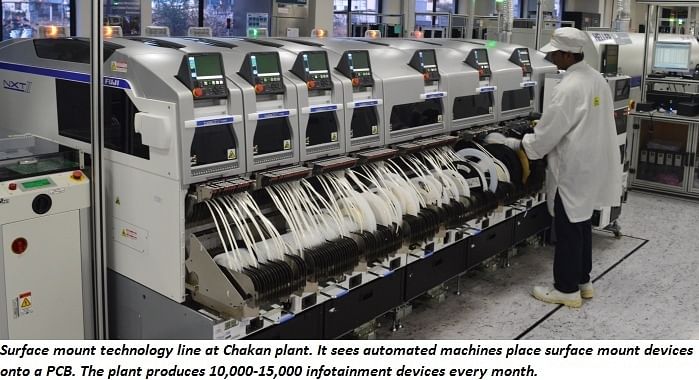Harman India eyes opportunities in evolving in-car infotainment space
Harman India, which has an acoustics centre in Pune and a production plant in Chakan, aims to make the most of the in-car infotainment space, a domain that is expected to see dramatic transformation in the future.
Harman International India’s latest in-car infotainment system can be seen in the recently launched Tata Tiago, a crucial model that involves high stakes for the company. The infotainment system is one of the many features on Tata Tiago that are being appreciated by experts.
Talking about his company’s engagement with Tata Motors over the last few years, PrathabDeivanayagham, head of connected car – India, Harman International, says: “The Zest was the first project. We started working with Tata Motors around 2012, which means we began engaging with them earlier than that. We started with a multi-year partnership, and the Zest, Bolt and Tiago were a part of the project pipeline. The systems that we have developed for Tata Motors are infotainment systems predominantly catering to two segments – entry small car (Bolt and Tiago) and entry mid-sized sedan category (Zest). Products developed by us are in two variants – entry radio and display audio.”
While the entry radio (AM/FM, Bluetooth, USB and AUX support) and display audio are internally classified terms, according to the senior company official, the entry radio solution is a segment-first in terms of giving a better user experience via bigger display and flow of functionalities. “Segment-first because a typical entry radio found in the market only offers a single-line segmented display with not much of additional features. So this was something where Harman and Tata Motors collaborated to deliver segment-first infotainment system for the end consumers,” he explains.
The display audio, as he says, is an entry level display unit with a bigger screen and lot of utility features such as support for reverse parking, voice recognition, smartphone projections and many others.

The infotainment solution for Tata Tiago has been built using a number of key takeaways from the one delivered for Tata Zest.
“In terms of takeaways from the Zest and Bolt projects, for the Tiago we developed turn-by-turn navigation support, which is provided through the smartphone map feature. So this project that we have delivered provides an alternate solution for an on-board navigation support, which makes up for a worthwhile experience for the users. If you look at the Zest’s infotainment unit in the context of form, fit and function, the device has a rectangular fascia. In the case of the Tiago, based on new cockpit design, there are modifications to the fascia, which means we have worked specifically on the styling and the mechanical designs. In terms of the functional features, we have worked on several additional features as well. This is how we have evolved with Tata Motors graduating with enhancements and features. The Tiago is the latest example of this,” highlights Prathab.
The platform architecture, however, remains the same through the evolving infotainment units. “The platform is the same as it has scalability in terms of architecture based on features set. So the platform does not change from product to product. The functional features, on the other hand, keep changing depending on OEMs’ plans for specific product segments and their individual requirements,” he adds.
Migration to 6-7-inch display units
The in-car infotainment industry has migrated from a single-DIN audio device, which was retailed and installed only in the aftermarket not many years ago. However, with an increase in its demand, the OEMs began factory fitment of the same. Even currently, a majority of passenger cars rolling out of the assembly lines in their factories come equipped with the entry-level audio device, which may or may not have a CD player.
“However, now as we see, the migration is more towards the display audio and this is enabled by the smartphone penetration. With increasing smartphone penetration in India and the changing profile of the car buyers, which is shifting towards the younger generation that stays connected via their phones, we see display audio as the next technology in demand. With Google and Apple enabling smartphone projection technology, it is becoming very easy for the end users to remain accessible to their smartphones even while on the go,” points out Prathab.

“This is a big evident change, which will drive volumes and the related business opportunities in the market. The trend is seen via Renault launching its affordable Kwid with touchscreen and navigation features, Maruti Suzuki via Baleno, Hyundai via Creta SUV and others.”
Prathab forecasts that this trend will pick up from its current stage and the cars will be increasingly seen with infotainment units with at least seven-inch touch screens.
Developed in India
The cost-effective infotainment solutions were conceived and developed in India, which was led by its engineering teams based in Pune and Bangalore. Harman’s engineering footprint under the connected car business unit in India has over 1,000 employees. Over 250 of them are based in Pune.
In this context, Prathab clarifies, “We drive the technologies from our global platforms yet remain innovative in terms of tailor-made functionalities suitable for the Indian market. That’s how we were able to pitch into Tata Motors and deliver such systems.”

Harman’s plant in Chakan, which now has two functional assembly lines, currently produces around 10,000-15,000 units per month. “We have a scalable capacity that can go up to half a million units per annum. Having an acoustics engineering centre in Pune and a production plant in Chakan is a key advantage,” he adds.
At 2016 Auto Expo, Tata Motors had revealed its almost production-ready concept of compact SUV – Nexon, which was lauded for its eye-catching design. The upcoming car will also feature a Harman-developed infotainment unit that is understood to sport a seven-inch floating touchscreen with around eight speakers.
“That has a seven-inch touchscreen and those types of infotainment systems will increasingly pick up in the coming future. That is the direction of this evolving market. In the seven-inch touchscreens, I believe, the OEMs have finally found a sweet spot in terms of the right size,” he quips.
Besides Tata Motors, the company is currently working with Volkswagen India, Fiat and is in active discussions with several OEMs over future projects. The senior official estimates that if the Indian passenger car industry grows, as per the projections, to 5-6 million units annually by 2020/21, the in-car infotainment segment could translate into a US$ 200-250 million opportunity.
“If the car industry grows at the rate at which it is projected to grow, five years from now, I think from an infotainment perspective, display audio including navigation (smart phone projections) could be close to 200-250 million USD. This is excluding entry navigation and entry radio devices, which are currently the dominating devices in the overall passenger car infotainment market,” he forecasts.
“This is if Indian passenger car market grows from 3 million units to 5-6 million units per annum. However, currently, OEM-fitted infotainment systems come in less than one million cars. Almost 60-70 percent of total car produced come with entry radio because they sell in the cost sensitive segments. Entry-navigation units are the biggest bet with bigger display touchscreens.”
According to a recently published report by Allied Market Research titled, ‘World In-Car Infotainment Market Opportunities and Forecasts, 2015-2022’, the world in-car infotainment market is expected to reach US$ 33.8 billion by 2022, registering a CAGR of 13.3 percent in 2016-2022. The report says that while Europe is the most promising region with surging demand, Asia-Pacific would be the fastest growing region over the forecast period.
RELATED ARTICLES
Hybrids Gain Ground as India’s EV Transition Faces Infrastructure, Cost Hurdles
Slower-than-expected EV adoption, tight CAFE norms and ever-present efficiency demands are giving hybrids a second wind ...
Continental Taps India as Global Hub for R&D and Manufacturing
Continental’s spin-off of its automotive business into AUMOVIO marks a strategic shift, placing India’s engineering and ...
India's EV Story: Promise, Progress, and Challenges
Amid the fanfare of new launches and soaring expectations, mainstream buyers remain hesitant.





 By Amit Panday
By Amit Panday
 09 Jun 2016
09 Jun 2016
 20069 Views
20069 Views












 Shahkar Abidi
Shahkar Abidi


